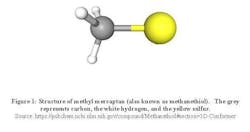Mercaptans are chemicals containing carbon, hydrogen, and sulfur. They are detectable at concentrations as low as 10 parts per billion. In some cases, mercaptans are used as an additive to odorless gases for detecting the odorless gases.
What are examples of mercaptans?
Methyl mercaptan (also known as methanethiol) is a common mercaptan. In addition to carbon, it contains sulfur as seen in the illustration in Figure 1. Another example of a common mercaptan is ethyl mercaptan that has the formula C2H5SH.
How are mercaptans formed in wastewater systems?
The wastewater coming in from the pipelines to the wastewater treatment facilities contains relatively high amount of organic substances. Oxygen is also limited in the wastewater, depending on the aerobic respiration rate and the re-aeration rate. Furthermore, the microorganisms that are also present in the wastewater oxidize the organic compounds, resulting in the generation of nitrogen and carbon dioxide along with the increase in the alkalinity of the surrounding aqueous environment.
In the absence of oxygen and nitrates, the electron acceptors are sulfides and carbon dioxide. This environment results in the production of hydrogen sulfides, mercaptans, and other reduced organic compounds.
How can mercaptans be removed?
The literature discusses several methods for the removal of mercaptans. These are categorized into biological, physical, and chemical mercaptan odor control techniques.
Biological techniques for controlling mercaptans odor
The biological techniques rely on the ability of microorganisms to break down mercaptans. For this to occur, several parameters need to be optimized. These include forcing air through the water media for more contact of the mercaptan with the microorganisms and for the breakdown of mercaptan. Bio-scrubbers are an example of a biological technique for controlling mercaptans odor.
Physical techniques for controlling mercaptans odor
An example of physical techniques include the use of adsorptive filters. These filters trap the mercaptan molecules, allowing them to be degraded by the microorganisms in the water.
Chemical techniques for controlling mercaptan odor
These techniques use chemicals that induce a chemical reaction to degrade mercaptans and produce by-products that can be removed.
Studies have shown that a combination of biological, physical, and chemical factors can help to remove mercaptans. For example, a study used pH optimization and microbial immobilization (a packed bed filled with immobilized microorganism beads) to remove hydrogen sulfides and methyl mercaptans.
Are mercaptans harmful to humans and what are they incompatible with?
The Agency for Toxic Substances and Disease Registry mentions the health effects from exposure to methyl mercaptan includes edema (swelling in body tissues) and depression of the central nervous system. It also states under acute exposure to methyl mercaptan, in addition to inhibiting mitochondrial respiration, also inhibits enzyme systems related to sodium and potassium ATPase.
Notably, the Agency for Toxic Substances and Disease Registry mentions under “Incompatibilities” that methyl mercaptan is incompatible with strong oxidizers and also with copper, aluminum, and nickel-copper alloys.
What are mercaptans commonly referred to as?
In general, mercaptans are organic thiol compounds. Organic thiols are a class of organic chemicals with the general formula R-S-H where R is an alkyl or any other organic substituent bonded to sulfur (S).
What smells like mercaptan?
Mercaptans are thiols that contain a sulfur molecule and among these, methyl mercaptans, according to the US EPA, is the most common thiol measured in gas emissions from biosolids.
The human nose can detect ethanethiol (which contains thiol) at a level of at least one hundred million times lower than ethanol (which is an alcohol compound and does not contain thiol).
What makes this sensitivity of the human nose possible? An article published by the American Chemical Society offers an explanation. The mammalian nose detects thiols and other odorants by the odorant receptors. The element copper is required in the human olfaction for responding to the gas odorants tert-butyl thiol and ethanethiol.
It is the presence of sulfur in mercaptans that gives them the smell, sensitive enough for the human olfaction to respond. Additionally, several mercaptans also have low odor threshold.
The National Institute of Environmental Health Sciences defines odor detection threshold as “the lowest concentration of a certain odor compound perceivable by the human sense of smell.” The EPA offers a similar definition – “the lowest concentration of an odorant that will elicit an olfactory response without reference to odor quality in a specified percentage of a given population.”
According to the EPA, the boiling temperature of methyl mercaptan is 6oC, and thus it is a gas at room temperature, allowing its smell to be detected at room temperature.
Methyl mercaptan has a sulfide odor and an odor threshold of 2.4 x 10-5 µg/L. There are other mercaptans with low odor threshold, also reported by the US EPA. Their smell and their odor threshold are in Table 1. These include n-butyl mercaptan with a skunk odor and an odor threshold value of 1.2 x 10-5 µg/l.
Table 1: Examples of mercaptans, their odor characteristic, and odor threshold.
US federal odorization laws
Title 49, §192.625 is on the odorization of gas. The following presents a summary of what is in this CFR:
- Title 49, §192.625 (a) states that a combustible gas in a distribution line must contain a natural odorant or be odorized so that the gas is readily detectable by a person with a normal sense of smell. This detectability is at a gas concentration in air of one-fifth of the lower explosive limit.
- Title 49, §192.625 (b) is on the compliance requirements after December 1976 for a combustible gas in a transmission line in a Class 3 or Class 4 location and the exceptions.
- Title 49, §192.625 (c) states that in the concentration at which the odorant is used in combustible gases, the odorant must not be deleterious to persons, materials, or pipe, may not be toxic when breathed nor corrosive, harmful to the materials. It also states that the odorant may not be soluble in water to an extent greater than 2.5 parts to 100 parts by weight.
Furthermore, this CFR also includes conducting periodic sampling of combustible gases to assure the proper concentration of odorant.
Are methyl mercaptans and ethyl mercaptans used as natural gas odorants?
The Hazardous Substance Fact Sheet from the New Jersey Department of Health and Senior Services mentions mercaptans could be used as natural gas odorants. However, another literature source mentions these are not commonly used as natural gas odorants.
Michanowicz et al. reported that in practice, natural gas odorants must possess several physical and chemical characteristics, as listed below, to be effective for detecting gas leak from odorless gases. Odorants must:
- have a strong and distinct odor
- a high degree of chemical stability in the natural gas system and the environment
- a high vapor pressure to avoid condensation
- a low freezing point
- not harmful to human health and to the surrounding infrastructure including to pipes
- must not create toxic combustion byproducts
To comply with safety regulations, natural gas utilities typically use blends of various gases containing organosulfur compounds. Examples of these gases include tert-butyl mercaptan and isopropyl mercaptan.
The ChemicalSafetyFacts.org from the American Chemistry Council explicitly consider methyl mercaptans to not be acceptable for use as a natural gas odorant. Specifically, the website for chemicalsafetyfacts.org states under “Uses & Benefits” that methyl mercaptan is not used as an odorant in natural gas, propane, and other gaseous fuels.
About the Author
Saleha Kuzniewski
Saleha Kuzniewski, Ph.D. has authored several publications in the fields of scientific research, biotechnology, and environmental regulations. She is the winner of the 2023 Apex award for publication excellence. She is also the founder of Environmental Remediation & Innovations, LLC. Kuzniewski can be reached at [email protected].



